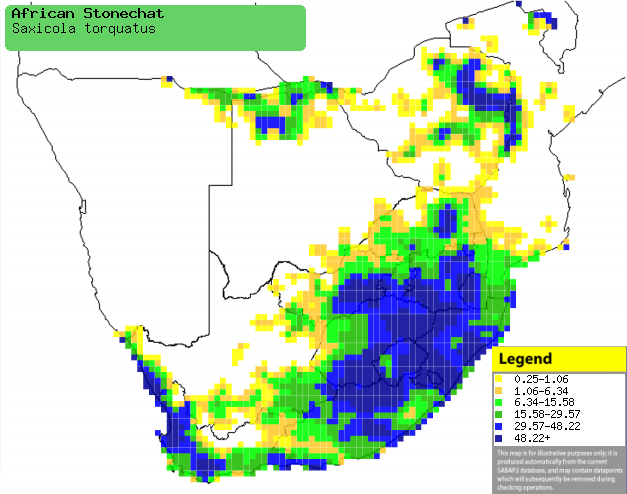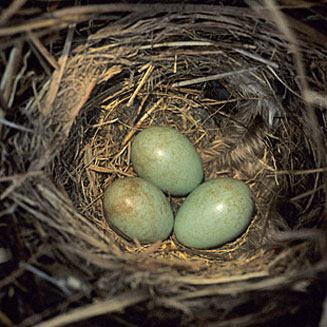|
Saxicola torquatus (African
stonechat)
Gewone bontrokkie [Afrikaans]; Ingcaphe, Isangcaphe [Xhosa];
isAncaphela, isAnqawane, isiChegu [Zulu]; Hlatsinyane, Tlhatsinyane [South
Sotho]; Aziatische roodborsttapuit [Dutch]; Tarier pātre [French];
Schwarzkehlchen [German]; Cartaxo-comum [Portuguese]
Life
> Eukaryotes >
Opisthokonta
> Metazoa (animals) >
Bilateria >
Deuterostomia > Chordata >
Craniata > Vertebrata (vertebrates) > Gnathostomata (jawed
vertebrates) > Teleostomi (teleost fish) > Osteichthyes (bony fish) > Class:
Sarcopterygii (lobe-finned
fish) > Stegocephalia (terrestrial
vertebrates) > Tetrapoda
(four-legged vertebrates) > Reptiliomorpha > Amniota >
Reptilia (reptiles) >
Romeriida > Diapsida > Archosauromorpha > Archosauria >
Dinosauria
(dinosaurs) > Saurischia > Theropoda (bipedal predatory dinosaurs) >
Coelurosauria > Maniraptora > Aves
(birds) >
Order: Passeriformes > Family: Muscicapidae
> Genus: Saxicola
Distribution and habitat
Occurs in patches across sub-Saharan Africa, but with the
bulk of its population located from eastern Sudan and Ethiopia through southern
DRC, Angola and Tanzania to southern Africa. Here it is common across much of
Zimbabwe, northern Botswana, Mozambique, South Africa and Caprivi Strip,
Namibia. It generally prefers montane or open grassland (with scattered shrubs
and bushes), fynbos shrubland, grassy hillsides, edges of high altitude forest,
swamp edges and cultivated land.
|
 |
|
Distribution of African stonechat in southern Africa,
based on statistical smoothing of the records from first SA Bird Atlas
Project (©
Animal Demography unit, University of
Cape Town; smoothing by Birgit Erni and Francesca Little). Colours range
from dark blue (most common) through to yellow (least common).
See here for the latest distribution
from the SABAP2. |
Brood parasites
It has been recorded as host of the
Red-chested cuckoo.
Food
It mainly eats insects and their larvae, supplemented with
other invertebrates, lizards, fruit and seeds. It does most of its foraging from
a perch, pouncing on prey on the ground and occasionally hawking insects
aerially. It may also forage along rocky shores, hawking prey such as fish from
perches on rocks and kelp. The following food items have been recorded
in its diet:
- Invertebrates
- Vertebrates
- Plants
Breeding
- The nest (see image below) built solely by the female, consisting of a
deep cup made of dry grass, rootlets and thin plant stems and lined with
finer rootlets, wool, hair and sometimes feathers. It is typically placed on
the ground or on a low bank, at the base of a grass tuft, herb or shrub,
although it was once recorded using a thorny tree as a nest site.
 |
|
|
African stonechat nest with eggs, Sericea
farm, South Africa. [photo Warwick Tarboton ©] |
|
- Egg-laying season is from July-December, peaking from August-November.
- It lays 2-5 eggs, which are incubated solely by the female for about
14-15 days.
- The chicks are brooded solely by the female but fed both parents,
leaving the nest after about 13-16 days, becoming fully independent about
2-3 weeks later.
Threats
Not threatened.
References
-
Hockey PAR, Dean WRJ and Ryan PG 2005. Roberts
- Birds of southern Africa, VIIth ed. The Trustees of the John Voelcker
Bird Book Fund, Cape Town.
|
